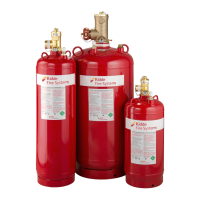Maintenance
October 2014 5-16 06-236115-001
5-8.3 Nitrogen Pilot Cylinders
1. Install nitrogen cylinder in mounting bracket. Rotate cylinder until valve outlet is in desired
position.
2. Tighten mounting bracket strap.
3. Remove pipe plug and connect adapter (Part No. WK-699205-010) to cylinder valve outlet
port. Attach flexible actuation hose to outlet port adapter.
4. Remove protection cap from cylinder valve control head port.
5. Install control head to cylinder valve.
6. Tighten the control head to the valve. Tightening the control head to the valve requires that
a wrench be used to hold the valve while the control head hex nut is tightened. The outlet
fitting (1/8 NPT to 5/16 tube connector) must be removed to expose the two flats on the
valve body (new cylinders are supplied with plastic shipping plug in this outlet).
7. Both the valve body and the control head hex nut are 1-1/2” across the flats. Hold the valve
body using a 1-1/2” wrench (preferred) or a suitable smooth jawed adjustable wrench.
8. Position the control head in the desired orientation and hand tighten the hex-nut. Using a
torque wrench
1
fitted with a 1-1/2" crowfoot wrench, tighten to a minimum torque of
60 ft· lb
2
.
9. Reinstall outlet fitting and connect to system hose, tubing or pipe (as appropriate).
1
Recommended 10-100 ft·lb 1/2” drive torque wrench. Other ranges are acceptable pro-
vided 40-60 ft·lb is within optimum tolerance for the tool.
2
Set wrench to a minimum setting of 55 ft·lb (most styles of crowfoot will increase the
actual torque value by approximately 10% since a typical 1-1/2" crowfoot wrench has a
center-to-center dimension of 2”. Actual minimum torque value is 60 ft· lb Calculate effect
of crowfoot using tool manufacturer’s data.
WARNING
Control head must be in the “set” or “closed” position before attaching to the
cylinder valve, which will prevent:
an accidental discharge of the nitrogen cylinder and any corresponding
suppression agent or nitrogen leak during actuation
Failure to properly set the control head may cause damage to the unit and could
result in one of the aforementioned concerns.

